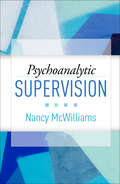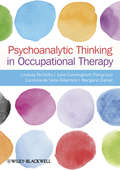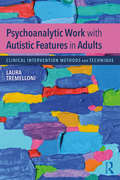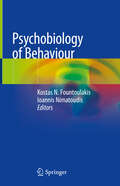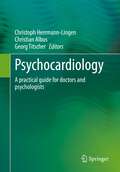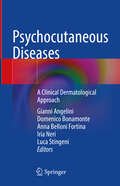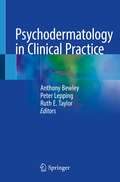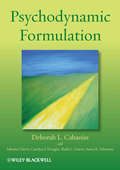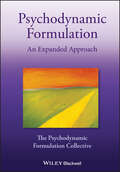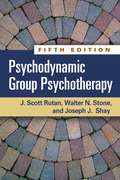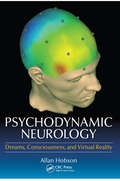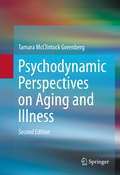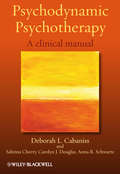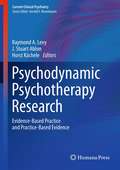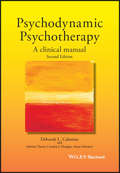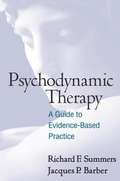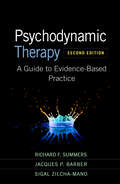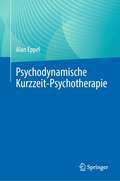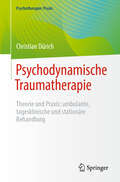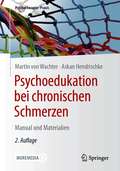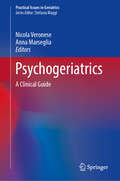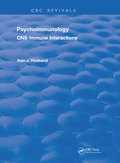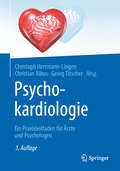- Table View
- List View
Psychoanalytic Supervision
by Nancy McWilliamsDrawing on deep reserves of experience and theoretical and research knowledge, Nancy McWilliams presents a fresh perspective on psychodynamic supervision in this highly instructive work. McWilliams examines the role of the supervisor in developing the therapist's clinical skills, giving support, helping to formulate and monitor treatment goals, and providing input on ethical dilemmas. Filled with candid clinical examples, the book addresses both individual and group supervision. Special attention is given to navigating personality dynamics, power imbalances, and various dimensions of diversity in the supervisory dyad. McWilliams guides mentors and mentees alike to optimize this unique relationship as a resource for lifelong professional learning and growth.
Psychoanalytic Thinking in Occupational Therapy
by Lindsey Nicholls Julie Cunningham-Piergrossi Margaret Daniel Carolina de Sena-GibertoniThis book is the first to use psychoanalysis as a basis for exploring how occupational therapists do their work, and it incorporates a new conceptual model to guide practice. The authors emphasize the role of the unconscious in all that people do and are, and argue that activities (or occupations) are simultaneously real (i.e. tangible) and symbolic. Ideal for academic and clinical occupational therapists, this book will also appeal to psychotherapists.
Psychoanalytic Work with Autistic Features in Adults: Clinical Intervention Methods and Technique
by Laura TremelloniPsychoanalytic Work with Autistic Features in Adults deals with the diagnostic and therapeutic difficulties of working with patients with autistic residuals, formed in early life experiences that have remained dormant in the unconscious mind. Laura Tremelloni traces the process of identifying them in adult patients, and stresses the need to develop a treatment plan suitable for this kind of pathology. This book uses clinical cases to examine the difficulties of work with hard to reach adults with 'gaps' in their sense of Self and symptoms related to primitive experiences of "non-being". Tremelloni presents new, adaptive therapeutic intervention methods for overcoming such obstacles and identifies the personification and permanence of undeveloped parts of the Self, in hard to reach adults who have otherwise developed satisfactorily and would not be diagnosed as autistic. In such cases, the author suggests the need for clinicians to adapt classic psychoanalytic approaches to the alternating levels of development of the separate parts which the Self has broken into. Psychoanalytic Work with Autistic Features in Adults will help clinicians in psychoanalysis and psychoanalytic psychotherapy to more effectively reach such patients, whilst attempting to address the problematic limitations of therapeutic techniques in very difficult clinical cases.
Psychobiology of Behaviour
by Kostas N. Fountoulakis Ioannis NimatoudisThe book provides a comprehensive reference on the neurobiological understanding of behaviour, how behaviour is regulated by the brain, and how such behaviours in turn influence the brain. The work offers an introduction to neural systems and genetics/epigenetics, followed by detailed study of a wide range of behaviours – temperament and personality, instincts and drives, memory and cognitive function, sex and sexual differentiation, ethology and evolutionary biology, aging, drug abuse and other problematic behaviors, psychophysiology and ultimately the links to biological psychiatry and psychopharmacology. Research findings on the neural basis of social behaviour are integrated across different levels of analysis, from molecular neurobiology and neural systems/behavioural neuroscience to fMRI imaging data on human social behaviour. The content covers research on both normal and abnormal behaviours, as well as developmental aspects. The target audience includes psychiatrists, neurologists, nurses, psychologists and all researchers and advanced students in behavioural, social and developmental neuroscience, as well as clinical neuroscientists.
Psychocardiology: A practical guide for doctors and psychologists
by Christoph Herrmann-Lingen Christian Albus Georg TitscherPsychosomatic diagnostics and therapy are of increasing importance in the acute treatment, prevention and rehabilitation of cardiovascular diseases. The connection between heart disease and the psyche as well as the psychosocial concomitant symptoms is well documented. Basics of cardiology and psychosomatic medicine Doctor-patient relationship Ethical issues, gender effects, psychocardiology along the lifespan Psychosomatic problem areas and comorbidities Causes and consequences: Personality factors, risk behaviors, depression, anxiety disorders Specific diagnostics and treatment concepts - outpatient and inpatient Interdisciplinary cooperationAcute Cardiology, Heart Failure Units and Rehabilitation In accordance with German and European recommendations and guidelines, among others Position Paper on the Importance of Psychosocial Factors in Cardiology from the DGK (German Society of Cardiology) National Health Care Guideline Chronic CHD ESC Guidelines on CVD Prevention in Clinical Practice Suitable for the courses according to the curricula "Basic Psychocardiological Care" (D) and "Cardiological Psychosomatics" (A). For deepening the corresponding contents of the courses "Basic Psychosomatic Care". The book offers cardiologists, internists, general practitioners, psychotherapists and psychologists all practice-relevant basics to be able to treat their patients in the best possible way.
Psychocutaneous Diseases: A Clinical Dermatological Approach
by Domenico Bonamonte Gianni Angelini Iria Neri Anna Belloni Fortina Luca StingeniThe terminology, classification, diagnosis and treatment of dermatological factitious disorders, falling within the broad scope of self-induced dermatological diseases, are the subject of open debate. The complexity of the topic is also linked to the involvement of different health professions who often refer to different classifications, whereas patients with these conditions need a consistent multidisciplinary approach. The purpose of this work, resulting in decades of field experience and of the joint efforts of both dermatologists and psychiatrists, is to clarify the terminology of these disorders and, above all, to analyze their clinical characteristics in detail, the first and pivotal sign of suspicion and diagnosis. Artificial dermatitis are self-induced diseases caused by various means and for diverse purposes. Illness can be mimicked with unlawful purposes, or to take advantage of professional situations (obtaining extension of illness, recognition of the condition as an occupational disease, reaching a higher class of invalidity). In these cases, the simulators are aware of their own action and its purposes. Conversely, there are cases of self-induced dermatitis dictated by psychiatric problems, such as psychosis, intellectual disability and personality disorders. Intrinsic motivation of such lesions is different: patient intends to draw attention, reacts to difficult environmental situations by involuntary somatization of the skin. Skin artifacts of illicit intent are true "simulations", while the lesions caused unconsciously by subjects with psychological disorders are "pathomimies". In addition to the groups of true simulation and “pathomimia”, another group of self-provoked dermatoses is due to coercive habits (excoriations, tics) in conscious subjects who recognize the urgency of a self-harming action. Psychocutaneous Diseases leaves room to the clinic features and motivations of artifacts, both perpetuated on oneself and on other people ("by proxy" factitious disorders). The topic is completed by the addition of chapters by psychiatric specialists, in order to address pathogenetic problems and therapeutic guidelines, as well as contributions that integrate the approach with medico-legal expertise. This unique work will support diagnosis by dermatologists, but also psychiatrists, psychologists, internists, forensic doctors and general practitioners.
Psychodermatology in Clinical Practice
by Ruth E. Taylor Anthony Bewley Peter LeppingThis book represents a simple, practical resource for all healthcare professionals working with dermatological patients with psychological aspects to their disease. The emphasis is on effective guidance rather than exhaustive case reviews, providing readers with a manual on the appropriate way to approach management of the patient in each case. Comprehensive in coverage, but concise in its delivery of information, Psychodermatology in Clinical Practice presents an idealized approach to management of psychodermatology patients within a global perspective, and provides practical tools to aid assessment of patients and in the decision-making process. It is suitable for dermatologists, psychiatrists and psychologists, dermatology nursing staff, primary care physicians and pediatricians.
Psychodynamic Formulation
by Ruth Graver Anna R. Schwartz Sabrina Cherry Deborah L. Cabaniss Carolyn J. DouglasHow do our patients come to be the way they are? What forces shape their conscious and unconscious thoughts and feelings? How can we use this information to best help them? Constructing psychodynamic formulations is one of the best ways for mental health professionals to answer questions like these. It can help clinicians in all mental health setting understand their patients, set treatment goals, choose therapeutic strategies, construct meaningful interventions and conduct treatment.Despite the centrality of psychodynamic formulation to our work with patients, few students are taught how to construct them in a clear systematic way. This book offers students and practitioners from all fields of mental health a clear, practical, operationalized method for constructing psychodynamic formulations, with an emphasis on the following steps: DESCRIBING problems and patternsREVIEWING the developmental historyLINKING problems and patterns to history using organizing ideas about development.The unique, up-to-date perspective of this book integrates psychodynamic theories with ideas about the role of genetics, trauma, and early cognitive and emotional difficulties on development to help clinicians develop effective formulations.Psychodynamic Formulation is written in the same clear, concise style of Psychodynamic Psychotherapy: A Clinical Manual (Wiley 2011). It is reader friendly, full of useful examples, eminently practical, suitable for either classroom or individual use, and applicable for all mental health professionals. It can stand alone or be used as a companion volume to the Clinical Manual.
Psychodynamic Formulation: An Expanded Approach
by The Psychodynamic Formulation CollectivePsychodynamic Formulation A leading text for psychodynamic clinicians and practitioners Psychodynamic Formulation: An Expanded Approach delivers an exceptional exploration of psychodynamic explanations and hypotheses that seek to explain how a person’s conscious and unconscious thoughts and feelings may have developed and may be causing or contributing to the challenges they face. This latest edition of the leading reference includes a refreshed and reinvigorated emphasis on the impacts of culture and society, as well as the importance of diversity and inclusion, on psychodynamic formulation. It puts new focus on lived experience, including trauma, and on how clinical bias can contribute to the perpetuation of trauma. In addition to newly included activities and exercises, readers will find: A practical, step-by-step guide to collaboratively creating psychodynamic formulations Comprehensive discussions about how what we’re born with and environmental influences contribute to development Suggestions for using psychodynamic formulations in many clinical settings, including acute care and psychopharmacologic treatment An educator’s guide to teaching psychodynamic formulation Perfect for mental health practitioners with a professional or personal interest in psychodynamics/psychoanalysis, Psychodynamic Formulation: An Expanded Approach will earn a place in the libraries of trainees in all mental health fields.
Psychodynamic Group Psychotherapy, Fifth Edition
by Walter N. Stone Joseph J. Shay J. Scott RutanRegarded as the definitive practitioner reference and text, this accessible work addresses all aspects of setting up therapy groups and making them work. A wealth of clinical material illustrates the components of effective group therapy and the mechanisms and processes of change. Practical topics discussed include patient selection and preparation, leadership issues, communication of affect in groups, dealing with "difficult" patients, time-limited groups, and facilitating successful terminations. A chapter-length case example with commentary from each author brings an entire group session to life and explores ways to handle common dilemmas. New to This Edition *Incorporates current theory (psychodynamic and interpersonal), which is grounded in clinical and neurobiological research. *Every chapter revised and updated. *Chapter-length case example is entirely new. *Chapter on Frequently Asked Questions includes many new issues.
Psychodynamic Neurology: Dreams, Consciousness, and Virtual Reality
by Allan HobsonPsychodynamic Neurology: Dreams, Consciousness, and Virtual Realty presents a novel way of thinking about the value of dreaming, based in solid comprehension of scientific research on sleep and dreams, but with deep understanding of psychoanalytic and other interpretations of dreams. <P><P>This book: <li>Surveys the remarkable history of sleep research over the past few decades <li>Examines the neurobiology of sleep and its implications for consciousness and well-being <li>Addresses the nature of waking and dreaming consciousness and how they are deeply related <li>Presents the neurogenesis, function, and clinical importance of a brain-based dream theory <P><P>Our dreams are a mixture of anticipated virtual as well as remembered real experience. This book tells the story of how neuroscience has helped us reach this startling and exciting conclusion and how the new scientific model builds upon and departs from the dream theories of the past.
Psychodynamic Perspectives on Aging and Illness
by Tamara Mcclintock GreenbergMore than ever, the aging process is recognized as carrying a special set of emotional challenges-especially when acute or chronic medical conditions are involved. In this light, Psychodynamic Perspectives on Aging and Illness presents a fresh, contemporary application of psychodynamic theory, addressing the complex issues surrounding declining health. Informed by the spectrum of psychodynamic thought from self, relational, and classical theories, this forward looking volume offers more modern interpretations of theory, and techniques for working with a growing, complicated, but surprisingly resilient population. It illuminates how to enhance the therapeutic relationship in key areas such as addressing body- and self-image issues, approach sensitive topics, and understand the disconnect that can occur between medical patients and the often impersonal, technology-driven health care system. At the same time, the author cogently argues for pluralism in a therapeutic approach that is frequently threatened by forces both within and outside the field. Among the topics covered: Medical illness as trauma. Idealization and the culture of medicine. Normative and pathological narcissism in the ill and/or aging patient. Noncompliant and self-destructive behaviors. Transference and countertransference issues. Psychotherapy with cognitively impaired adults. Grief, loss, and hope. Expanding on what we know and candid about what we don't, Psychodynamic Perspectives on Aging and Illness offers mental health researchers and practitioners an insightful framework for improving the lives of older patients.
Psychodynamic Psychotherapy
by Anna R. Schwartz Sabrina Cherry Deborah L. Cabaniss Carolyn J. DouglasPsychodynamic psychotherapy offers people a chance to create new ways of thinking and behaving in order to improve the quality of their lives.This book offers a practical, step-by-step guide to the technique of psychodynamic psychotherapy, with instruction on listening, reflecting, and intervening. It will systematically take the reader from evaluation to termination using straightforward language and carefully annotated examples. Written by experienced educators and based on a tried and tested syllabus, this book provides clinically relevant and accessible aspects of theories of treatment processes. The workbook style exercises in this book allow readers to practice what they learn in each section and more "actively" learn as they read the book.This book will teach you:About psychodynamic psychotherapy and some of the ways it is hypothesized to workHow to evaluate patients for psychodynamic psychotherapy, including assessment of ego function and defensesThe essentials for beginning the treatment, including fostering the therapeutic alliance, setting the frame, and setting goalsA systematic way for listening to patients, reflecting on what you've heard, and making choices about how and what to sayHow to apply the Listen/Reflect/Intervene method to the essential elements of psychodynamic techniqueHow these techniques are used to address problems with self esteem, relationships with others, characteristic ways of adapting, and other ego functionsWays in which technique shifts over timeThis book presents complex concepts in a clear way that will be approachable for all readers. It is an invaluable guide for psychiatry residents, psychology students, and social work students, but also offers practicing clinicians in these areas a new way to think about psychodynamic psychotherapy. The practical approach and guided exercises make this an exceptional tool for psychotherapy educators teaching all levels of learners.This book includes a companion website: www.wiley.com/go/cabaniss/psychotherapywith the "Listening Exercise" for Chapter 16 (Learning to Listen). This is a short recording that will help the reader to learn about different ways we listen.Praise for Psychodynamic Psychotherapy: A Clinical Manual"This book has a more practical, hands-on, active learning approach than existing books on psychodynamic therapy."Bob Bornstein, co-editor of Principles of Psychotherapy; Adelphi University, NY"Well-written, concise and crystal clear for any clinician who wishes to understand and practice psychodynamic psychotherapy. Full of real-world clinical vignettes, jargon-free and useful in understanding how to assess, introduce and begin psychotherapy with a patient. Extraordinarily practical with numerous examples of how to listen to and talk with patients while retaining a sophistication about the complexity of the therapeutic interaction. My trainees have said that this book finally allowed them to understand what psychodynamic psychotherapy is all about!"--Debra Katz, Vice Chair for Education at the University of Kentucky and Director of Psychiatry Residency Training"This volume offers a comprehensive learning guide for psychodynamic psychotherapy training."--Robert Glick, Professor, Columbia University(Cover painting by Nicki Averill)
Psychodynamic Psychotherapy Research
by J. Stuart Ablon Raymond A. Levy Horst KächelePsychodynamic Psychotherapy Research: Evidence-Based Practice and Practice-Based Evidence continues the important work of the first book published in 2009 by Humana Press (Handbook of Evidence-Based Psychodynamic Psychotherapy: Bridging the Gap Between Science and Practice). This landmark title presents in one volume significant developments in research, including neuroscience research, in psychodynamic psychotherapy by a team of renowned clinician-researchers. The demand for ongoing research initiatives in psychodynamic psychotherapy from both internal and external sources has increased markedly in recent years, and this volume continues to demonstrate the efficacy and effectiveness of a psychodynamic approach to psychotherapeutic interventions in the treatment of psychological problems. The work in this volume is presented in the spirit of ongoing discussion between researchers and clinicians about the value of specific approaches to specific patients with specific psychiatric and psychological problems. Multiple forms of treatment interventions have been developed over the past fifty years, and this volume makes clear, with firm evidence, the authors' support for the current emphasis on personalized medicine. Groundbreaking and a major contribution to the psychiatric and psychologic literature, Psychodynamic Psychotherapy Research: Evidence-Based Practice and Practice-Based Evidence provides firm grounding for advancing psychodynamic psychotherapy as a treatment paradigm.
Psychodynamic Psychotherapy: A Clinical Manual
by Anna R. Schwartz Sabrina Cherry Deborah L. Cabaniss Carolyn J. DouglasAn updated and expanded new edition of a widely-used guide to the theory and practice of psychodynamic psychotherapy, providing material for readers to apply immediately in their treatment of patients. Built around a unique and proven approach that clearly teaches psychodynamic psychotherapy using three key steps - listening, reflecting, and intervening Features new and expanded workbook-style exercises across all chapters, helping readers to translate what they are learning into real-world practice with patients Offers a comprehensive learning guide for psychodynamic therapy based on a proven syllabus for trainees in psychiatry, psychology, social work, medicine, nursing, and psychoanalysis A clear and comprehensive teaching text, now supported by a brand new educators' guide to assist teachers and program directors in making best use of the material in training programs
Psychodynamic Techniques
by Nancy Mcwilliams Karen MarodaHelping therapists navigate the complexities of emotional interactions with clients, this book provides practical clinical guidelines. Master clinician Karen J. Maroda adds an important dimension to the psychodynamic literature by exploring the role of both clients' and therapists' emotional experiences in the process of therapy. The book discusses how to become more attuned to one's own experience of a client; offer direct feedback and self-disclosure in the service of treatment goals; and manage intense feelings and conflict in the relationship. Specific techniques are illustrated with vivid case examples. Maroda clearly distinguishes between therapeutic and nontherapeutic ways to work with emotion in this candid and instructive guide.
Psychodynamic Therapy
by Jacques Barber Richard SummersPresenting a pragmatic, evidence-based approach to conducting psychodynamic therapy, this engaging guide is firmly grounded in contemporary clinical practice and research. The book reflects an openness to new influences on dynamic technique, such as cognitive-behavioral therapy and positive psychology. It offers a fresh understanding of the most common problems for which patients seek help depression, obsessionality, low self-esteem, fear of abandonment, panic, and trauma and shows how to organize and deliver effective psychodynamic interventions. Extensive case material illustrates each stage of therapy, from engagement to termination. Special topics include ways to integrate individual treatment with psychopharmacology and with couple or family work.
Psychodynamic Therapy: A Guide to Evidence-Based Practice
by Richard F. Summers Jacques P. Barber Sigal Zilcha-ManoFirmly grounded in contemporary clinical practice and research, this pragmatic guide for professionals and students is now in a revised and expanded second edition. The book explains the theory underlying psychodynamic approaches and lays out a model for understanding psychopathology. Vivid case examples demonstrate how to tailor psychodynamic therapy effectively for individual patients. The authors provide a framework for diagnosing the patient&’s core psychodynamic problem and engaging the most useful mechanisms of change, using an integrative approach. Special topics include remote and hybrid treatment, combining therapy with psychopharmacology, and working with couples and families. New to This Edition *Incorporates cutting-edge research on psychotherapy process and mechanisms of change. *Chapter on telepsychotherapy, including clear recommendations for practice. *More attention to the social determinants of health--the psychic effects of adversity and various forms of oppression. *New and revised case examples, with diversity in age, gender, race, culture, and sexual identity. See also Practicing Psychodynamic Therapy: A Casebook, edited by Summers and Barber, which features 12 in-depth cases that explicitly illustrate the approach in this book.
Psychodynamische Kurzzeit-Psychotherapie
by Alan EppelDieses Buch ist ein benutzerfreundlicher Leitfaden zur psychodynamischen Kurzzeit-Psychotherapie für Berufsanfänger und Studenten der Psychiatrie. Dieses Buch wurde von einem erfahrenen Psychiatriepädagogen geschrieben und sorgfältig auf Klarheit und Prägnanz hin konzipiert, um eine qualitativ hochwertige Ausbildung und Praxis zu ermöglichen. In einer leserfreundlichen Sprache beginnt der Text mit einer Einführung in die theoretischen Grundlagen der psychodynamischen Psychotherapie. Zu den Themen gehören die Prinzipien der Bindungstheorie, die duale Systemtheorie der Emotionsverarbeitung, die Entscheidungstheorie, die Wahlpunktanalyse und ein kritischer Überblick über die Forschungsliteratur. Der Schwerpunkt des Buches liegt dann auf der Beschreibung der Ziele und Aufgaben der einzelnen Therapiephasen im Rahmen der Einführungs-, der Emotionsverarbeitungs- und der Beendigungsphase in einem manualisierten Format. Das Buch schließt mit einem Kapitel über psychodynamisch informierte klinische Praxis für Nicht-Psychotherapeuten.Die psychodynamische Kurzzeit-Psychotherapie ist das ultimative Werkzeug für die Ausbildung von Studenten, Assistenzärzten, Praktikanten und Stipendiaten in der Psychiatrie, Psychologie, Beratung, Sozialarbeit und allen anderen klinischen Berufen der psychischen Gesundheit.
Psychodynamische Psychotherapien
by Ulrich Rüger Christian ReimerMit Focus auf das Wesentliche vermitteln die Autoren die tiefenpsychologischen Psychotherapieverfahren und berücksichtigen dafür aktuelle wissenschaftliche Studien. Der Band gliedert sich in die drei Teile Grundlagen, Verfahren und Störungen und enthält praxisbezogene Psychotherapiebehandlungspläne. Die Neuauflage wurde um Kapitel zur Ausbildungssituation in der Psychotherapie, zu Kostenträgern und zu gesetzlichen Rahmenbedingungen ergänzt.
Psychodynamische Traumatherapie: Theorie und Praxis: ambulante, tagesklinische und stationäre Behandlung (Psychotherapie: Praxis)
by Christian DürichIn diesem Buch wird die Behandlung von Traumafolgestörungen mit der Psychodynamischen Psychotherapie in ambulanter Praxis, Tagesklinik und stationärer Psychotherapie dargestellt. Verschiedene Krankheitsbilder mit unterschiedlichen Störungsschweren zählen zu den Traumafolgestörungen. Nicht immer können diese durchgängig in einem Setting behandelt werden. Vor diesem Hintergrund wird die sektorenübergreifende Behandlung mitsamt Indikationsstellung für die jeweiligen Settings ausgeführt. Als moderne Psychodynamische Psychotherapie, die mit ihren Anwendungsformen der Analytischen und Tiefenpsychologisch fundierten Psychotherapie zwei wesentliche Säulen der psychotherapeutischen Versorgung begründet, integriert eine psychoanalytisch orientierte Traumatherapie das gesamte Spektrum von Konflikt-, Ich- und Selbst-Psychologie, Objektbeziehungstheorie sowie Intersubjektivität. Die Behandlung von Traumafolgestörungen wird für beide Anwendungsformen eigenständig dargestellt, hinzu kommt der Einbezug störungsspezifischer Methoden wie Stabilisierungstechniken und Konfrontationsverfahren. Über den Autor: Dr. med. Christian Dürich, Facharzt für Psychosomatische Medizin und Psychotherapie und Psychoanalytiker/Gruppenanalytiker, ist Chefarzt der Psychosomatik am Katholischen Krankenhaus Hagen. Er ist weiterbildungsermächtigter Arzt der Ärztekammer Westfalen-Lippe und Vorsitzender der Westfälischen Arbeitsgemeinschaft für Psychosomatik, Psychotherapie und Psychoanalyse.
Psychoedukation bei chronischen Schmerzen: Manual und Materialien (Psychotherapie: Praxis)
by Askan Hendrischke Martin von WachterDieses Buch stellt 12 psychoedukative Module zur Schulung im Einzel- und im Gruppensetting vor und gibt eine Fülle von Anregungen. Angesprochen sind ärztliche und psychologische Psychotherapeuten, schmerzmedizinisch tätige Ärzte, aber auch Physio- und Ergotherapeuten, Pflegekräfte oder Mitarbeiter im Bereich der Gesundheitsförderung. Nach einer Einführung zur Psychoedukation gehen die erfahrenen Autoren Schritt für Schritt auf verschiedene Schmerzerkrankungen ein. – Voraussetzung für eine aktive Teilnahme der Patienten an einer erfolgreichen Schmerztherapie ist die Kenntnis über Ursachen, Sinn der Behandlung und ihrer Therapiebausteine sowie über das Zusammenwirken körperlicher, psychischer und sozialer Krankheitsfaktoren. Aus dem Inhalt: Support durch Übungen, Arbeitsblätter und Präsentationsfolien zum Download. Edukationsfilme, Selbsthilfeliteratur, Apps und Internetlinks werden vorgestellt. Auf eine Einbeziehung der Angehörigen und der Selbsthilfe wird ausführlich eingegangen. Für Problemsituationen bietet das Buch umfangreiche Hilfestellungen, die sich bewährt haben. Die Autoren: Dr. med. Martin von Wachter, Facharzt für Psychosomatik mit Zusatzausbildung in psychosomatischer Schmerztherapie (IGPS), Ltd. Arzt der Sektion Schmerztherapie der Klinik für Psychosomatik am Ostalb-Klinikum Aalen. Supervisor für Schmerzpsychotherapie. Dr. med. Askan Hendrischke, Facharzt für Psychosomatik, Facharzt für Allgemeinmedizin. Lehrender Therapeut für Systemische Therapie.
Psychogeriatrics: A Clinical Guide (Practical Issues in Geriatrics)
by Nicola Veronese Anna MarsegliaThe book offers a must-have tool primarily for psychiatrists, geriatricians, neurologists, and psychologists, but will also be of interest to general practitioners for first line assessment. The aim of this book is to establish a gold standard: a reference work to be used as a clinical guide to the assessment of mental illness in older persons in the field. Psychogeriatrics is generally a very specific field in the midst of different disciplines, where there is hardly a clinical consensus on how to best assess and treat elderly subjects with mental or behavioral symptoms, possibly resulting from psychiatric disorders. This book provides clear and practical indications, prepared by a panel of international experts in the field with extensive scientific and clinical experience. Boxes with first and second line actions for assessing and treating mental illness in the elderly are included, and all chapters are uniformly divided into sections on epidemiology, etiopathogenesis, differential diagnosis, assessment, and treatment.
Psychoimmunology: CNS Immune Interactions (Routledge Revivals)
by Alan J. HusbandFirst published in 1993, Psychoimmunology: CNS-Immune Interactions is based on papers presented at the Second International Scientific Meeting of the Australian Behavioral Immunology Group, held at the University of Newcastle in Australia on March 7 and 8, 1992. Information featured in the volume confirms the longstanding perception that state of mind and behavioral patterns have an impact on general health. Clinicians discuss correlations between lifestyle, stress, and disease, while scientists reveal their findings on ways in which deliberate manipulations of the central nervous systems and behavioral patterns are reflected in changes in immunological outcome. Other papers present findings regarding the mediators of these interactions, which include cytokines, hormones, and neurotransmitters. Psychoimmunology: CNS-Immune Interactions will be a useful reference for psychoimmunologists, immunologists, psychologists, microbiologists, and all medical and behavioral scientists interested in the links between brain behavior and disease.
Psychokardiologie: Ein Praxisleitfaden für Ärzte und Psychologen
by Christoph Herrmann-Lingen Christian Albus Georg TitscherDie psychosomatische Diagnostik und Therapie hat eine zunehmend wichtige Bedeutung bei der Akutbehandlung, Prävention und Rehabilitation kardiovaskulärer Erkrankungen.Der Zusammenhang zwischen Herzerkrankungen und Psyche sowie den psychosozialen Begleiterscheinungen ist gut belegt. Grundlagen der Kardiologie und psychosomatischen MedizinArzt-Patienten-BeziehungEthische Fragestellungen, Gendereffekte, Psychokardiologie entlang der LebensspannePsychosomatische Problemfelder und KomorbiditätenUrsachen und Folgen: Persönlichkeitsfaktoren, Risikoverhalten, Depression, Angststörungen …Spezifische Diagnostik und Behandlungskonzepte – ambulant und stationärInterdisziplinäre Zusammenarbeit NEU u.a. Collaborative careAkut-Kardiologie, Heart Failure UnitsRehabilitation Entsprechend den deutschen und europäischen Empfehlungen und Leitlinien u.a. DGK Positionspapier zur Bedeutung psychosozialer Faktoren in der KardiologieNationale VersorgungsLeitlinie Chronische KHKESC CVD Prevention in Clinical Practice Geeignet für die Kurse nach den Curricula „Psychokardiologische Grundversorgung“ (D) und „Kardiologische Psychosomatik“ (AU). Zur Vertiefung der entsprechenden Inhalte der Kurse „Psychosomatische Grundversorgung“.Das Buch bietet Kardiologen, Internisten, Allgemeinmedizinern, Psychotherapeuten und Psychologen alle praxisrelevanten Grundlagen, um ihre Patienten bestmöglich behandeln zu können.
